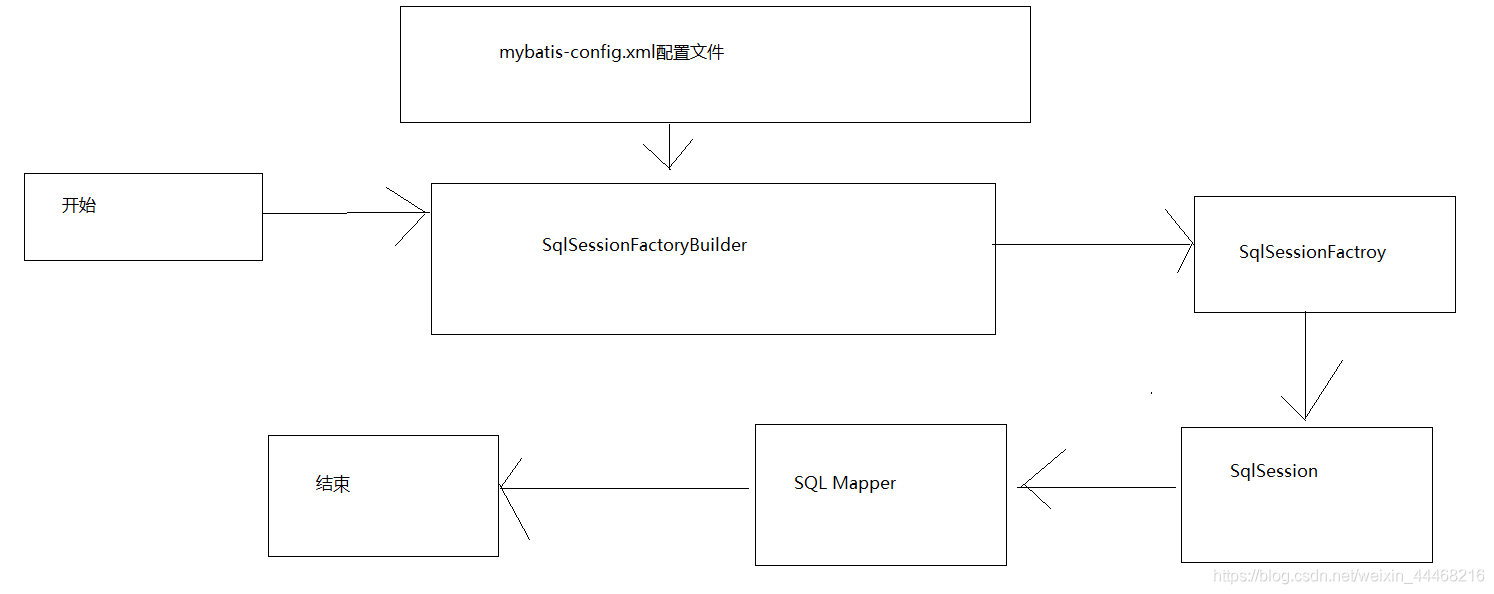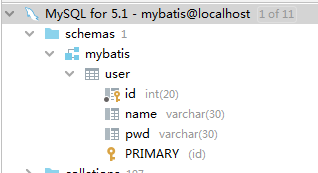简介
什么是MyBatis?
mybatis官网:https://mybatis.org/mybatis-3/zh/index.html
- MyBatis 是一款优秀的持久层框架,
- 它支持自定义 SQL、存储过程以及高级映射。
- MyBatis 免除了几乎所有的 JDBC 代码以及设置参数和获取结果集的工作。
- MyBatis 可以通过简单的 XML 或注解来配置和映射原始类型、接口和 Java POJO(Plain Old Java Objects,普通老式 Java 对象)为数据库中的记录。
- MyBatis 本是apache的一个开源项目iBatis, 2010年这个项目由apache software foundation
迁移到了google code,并且改名为MyBatis 。 - 2013年11月迁移到Github。
如何获得Mybatis? - mavaen仓库
<!-- https://mvnrepository.com/artifact/org.mybatis/mybatis -->
<dependency>
<groupId>org.mybatis</groupId>
<artifactId>mybatis</artifactId>
<version>3.4.6</version>
</dependency>
- GitHub
持久化
数据持久化
- 持久化就是将程序的数据在持久状态和瞬时状态转化的过程
- 内存:断电即失
- 数据库(jdbc),io文件持久化.
- 生活:冷藏,罐头
为什么需要持久化? - 有一些对象,不能让他丢掉.
- 内存太贵
持久层
Dao层,Service层,Controller层
- 完成持久化工作的代码块
- 层界限什么明显
为什么需要Mybatis?
- 帮助程序员将数据存入到数据库中.
- 方便
- 传统的JDBC代码太复杂了.简化.框架.
- 不用Mybatis也可以.更容易上手.技术没有高低之分.
- 简单易学:本身就很小且简单。
- 灵活
- sql和代码的分离,提高了可维护性。
- 提供映射标签,支持对象与数据库的orm字段关系映射
- 提供对象关系映射标签,支持对象关系组建维护
- 提供xml标签,支持编写动态sql。
最重要的一点:使用的人多.
第一个Mybatis程序
思路:搭建环境–>导入mybatis–>编写代码–>测试!
搭建环境
搭建数据库
CREATE DATABASE mybatis
USE mybatis
CREATE TABLE `user` (
`id` INT(20) NOT NULL,
`name` VARCHAR(30) DEFAULT NULL,
`pwd` VARCHAR(30) DEFAULT NULL,
PRIMARY KEY(`id`)
)ENGINE=INNODB DEFAULT CHARSET=utf8;
INSERT INTO `user` (id,`name`,pwd)
VALUES(4,'死神','123456'),
(5,'亡灵','123456'),
(6,'魅魔','123456')
新建项目
<?xml version="1.0" encoding="UTF-8"?>
<project xmlns="http://maven.apache.org/POM/4.0.0"
xmlns:xsi="http://www.w3.org/2001/XMLSchema-instance"
xsi:schemaLocation="http://maven.apache.org/POM/4.0.0 http://maven.apache.org/xsd/maven-4.0.0.xsd">
<modelVersion>4.0.0</modelVersion>
<!-- 父工程 -->
<groupId>com.n7</groupId>
<artifactId>mybatis-study</artifactId>
<version>1.0-SNAPSHOT</version>
<!-- 导入依赖 -->
<dependencies>
<!-- mysql驱动 -->
<dependency>
<groupId>mysql</groupId>
<artifactId>mysql-connector-java</artifactId>
<version>5.1.46</version>
</dependency>
<!-- mybatis -->
<dependency>
<groupId>org.mybatis</groupId>
<artifactId>mybatis</artifactId>
<version>3.5.2</version>
</dependency>
<!-- junit -->
<dependency>
<groupId>junit</groupId>
<artifactId>junit</artifactId>
<version>4.12</version>
</dependency>
</dependencies>
</project>
创建一个模块
编写mybatis核心配置文件
<?xml version="1.0" encoding="UTF-8" ?>
<!DOCTYPE configuration
PUBLIC "-//mybatis.org//DTD Config 3.0//EN"
"http://mybatis.org/dtd/mybatis-3-config.dtd">
<configuration>
<environments default="development">
<environment id="development">
<transactionManager type="JDBC"/>
<dataSource type="POOLED">
<property name="driver" value="$com.mysql.jdbc.Driver"/>
<property name="url" value="jdbc:mysql://localhost:3306/mybatis?useSSL=true&useUnicode=true&characterEncoding=UTF-8"/>
<property name="username" value="root"/>
<property name="password" value="root"/>
</dataSource>
</environment>
</environments>
<mappers>
<mapper resource="org/mybatis/example/BlogMapper.xml"/>
</mappers>
</configuration>
编写mybatis工具类
public class MybatisUtils {
private static SqlSessionFactory sqlSessionFactory;
static {
try {
//使用mybatis第一步:获取sqlSessionFactory对象
String resource ="mybatis-config.xml";
InputStream inputStream = Resources.getResourceAsStream(resource);
sqlSessionFactory = new SqlSessionFactoryBuilder().build(inputStream);
} catch (IOException e) {
e.printStackTrace();
}
}
//既然有了 SqlSessionFactory,顾名思义,我们可以从中获得 SqlSession 的实例。
// SqlSession 提供了在数据库执行 SQL 命令所需的所有方法。
public static SqlSession getSqlSession(){
return sqlSessionFactory.openSession();
}
}
编写代码
实体类
public class User {
private int id;
private String name;
private String pwd;
public User() {
}
public User(int id, String name, String pwd) {
this.id = id;
this.name = name;
this.pwd = pwd;
}
public int getId() {
return id;
}
public void setId(int id) {
this.id = id;
}
public String getName() {
return name;
}
public void setName(String name) {
this.name = name;
}
public String getPwd() {
return pwd;
}
public void setPwd(String pwd) {
this.pwd = pwd;
}
@Override
public String toString() {
return "User{" +
"id=" + id +
", name='" + name + '\'' +
", pwd='" + pwd + '\'' +
'}';
}
}
Dao接口
public interface UserDao {
List<User> getUserList();
}
接口实现类由原来的UserDaoImpl转换为一个Mapper配置文件
<?xml version="1.0" encoding="UTF-8" ?>
<!DOCTYPE mapper
PUBLIC "-//mybatis.org//DTD Mapper 3.0//EN"
"http://mybatis.org/dtd/mybatis-3-mapper.dtd">
<!-- namespace=绑定一个对应的Dao/Mapper接口 -->
<mapper namespace="com.n7.dao.UserDao">
<select id="getUserList" resltType="com.n7.pojo.User">
select * from mybatis.user;
</select>
</mapper>
测试
MapperRegistry是什么?
核心配置文件中注册mappers
- junit测试
public class UserDaoTest {
@Test
public void test(){
//第一步:获取sqlSession对象
SqlSession sqlSession = MybatisUtils.getSqlSession();
//方式一:getMapper
UserDao userDao = sqlSession.getMapper(UserDao.class);
List<User> userList = userDao.getUserList();
for (User user : userList) {
System.out.println(user);
}
//关闭sqlSession
sqlSession.close();
}
}
你们可能遇到的问题:
- 配置文件没有配置
- 绑定接口错误
- 方法名不对
- 返回类型不对
- Maven导出资源问题
CRUD
namespace
namespace中的包名要和接口的包名一致.
select
选择,查询语句;
- id:就是对应的namespace中的方法名;
- resultType:sql语句执行的返回值;
- parameterType:参数类型
1.编写接口
//根据id查询
User getUserById(int id);
2.编写对应的mapper中的sql语句
<select id="getUserById" parameterType="int" resultType="com.n7.pojo.User">
select * from mybatis.user where id = #{id}
</select>
3.测试
public void getUserById(){
SqlSession sqlSession = MybatisUtils.getSqlSession();
UserDao mapper = sqlSession.getMapper(UserDao.class);
User user = mapper.getUserById(1);
System.out.println(user);
sqlSession.close();
}
insert
<!-- 对象中的属性,可以直接取出来 -->
<insert id="addUser" parameterType="com.n7.pojo.User" >
insert into mybatis.user(id,name,pwd) values(#{id},#{name},#{pwd});
</insert>
update
<update id="updateUser" parameterType="com.n7.pojo.User">
update mybatis.user set name=#{name},pwd=#{pwd} where id=#{id};
</update>
delete
<delete id="deleteUser" parameterType="int">
delete from mybatis.user where id=#{id};
</delete>
注意点:
- 增删改需要提交事务 sqlSession.commit();
错误分析
- 标签不要匹配错
- resource绑定mapper,需要使用路径
- 程序必须符合规范
- NullPointException,没有注册到资源
- 输出的xml文件中存在中文乱码问题
- maven资源没有导出问题
万能Map
假设我们的实体类,或者数据库中的表,字段或者参数过多,我们应该考虑用Map;
User getUserById2(Map<String,Object> map);
<insert id="addUser2" parameterType="map" >
insert into mybatis.user(id,name,pwd) values(#{userid},#{userName},#{password});
</insert>-->
@Test
public void addUser2(){
SqlSession sqlSession = MybatisUtils.getSqlSession();
UserDao mapper = sqlSession.getMapper(UserDao.class);
HashMap<String, Object> map = new HashMap<>();
map.put("userid", 7);
map.put("userName", "卡哇伊");
map.put("psswod", "777");
mapper.addUser2(map);
sqlSession.commit();
sqlSession.close();
}
Map传递参数,直接在sql中取出key即可. parameterType:“map”
对象传递参数,直接在sql中取对象的属性即可. parameterType:“Object”
只有一个基本类型参数的情况下,可以直接在sql中取到.
多个参数中用Map,或者注解.
思考题
模糊查询怎么写?
- Java代码执行的时候,传递通配符% %
List<user> userList = mapper.getUserLike("%李%");
- 在sql拼接中使用通配符.
select * from mybatis.user where name like "%"{value}"%";
配置解析
核心配置文件
- mybatis-config.xml
- MyBatis的配置文件包含了会深深影响MyBatis行为的设置和属性信息
configuration(配置)
properties(属性)
settings(设置)
typeAliases(类型别名)
typeHandlers(类型处理器)
objectFactory(对象工厂)
plugins(插件)
environments(环境配置)
environment(环境变量)
transactionManager(事务管理器)
dataSource(数据源)
databaseIdProvider(数据库厂商标识)
mappers(映射器)
环境配置(environments)
MyBatis 可以配置成适应多种环境.
尽管可以配置多个环境,每个SqlSessionFactory 实例只能选择一种环境.
学会使用配置多套运行环境.
Mybatis默认的事务管理器就是JDBC, 连接池:POOLED
属性(properties)
我们可以通过properties属性来实现引用配置文件
这些属性可以在外部进行配置,并可以进行动态替换。你既可以在典型的 Java 属性文件中配置这些属性,也可以在 properties 元素的子元素中设置。[db.properties]
编写一个配置文件
db.properties
driver=com.mysql.jdbc.Driver
url=jdbc:mysql://localhost:3306/mybatis?useSSL=true&useUnicode=true&characterEncoding=UTF-8
username=root
password=root
<!-- 引入外部配置文件 -->
<properties resource="db.properties"/>
- 可以直接引入外部文件
- 可以在其中增加一些属性配置
- 如果两个文件有同一个字段,优先使用外部配置文件的.
类型别名(typeAliases)
- 类型别名可为 Java 类型设置一个缩写名字。
- 意在降低冗余的全限定类名书写,
<!-- 可以给实体类起别名 -->
<typeAliases>
<typeAlias type="com.n7.pojo.User" alias="User"/>
</typeAliases>
也可以指定一个包名,MyBatis 会在包名下面搜索需要的 Java Bean.
扫描实体类的包,它的默认别名就是为这个类 类名,首字母小写.
<!-- 可以给实体类起别名 -->
<typeAliases>
<package name="com.n7.pojo"/>
</typeAliases>
在实体类比较少的的时候使用第一种.
在实体类比较多的时候建议使用第二种.
第一种可以diy别名,第二种不行.如果非要改,需要在实体类上增加注解
@Alias("this")
public class User {
private int id;
private String name;
private String pwd;
}
设置(settings)
这是 MyBatis 中极为重要的调整设置,它们会改变 MyBatis 的运行时行为。
映射器(mappers)
MapperRegistry: 注册绑定我们的Mapper文件;
方式一:
<!-- 每一个Mapper.xml都需要在Mybatis核心配置文件中注册 -->
<mappers>
<mapper resource="com/n7/dao/UserMapper.xml"/>
</mappers>
方式二:使用class文件绑定注册
<mappers>
<mapper class="com.n7.dao.UserMapper"/>
</mappers>
注意点:
- 接口和他的Mapper配置文件必须同名.
- 接口和他的Mapper配置文件必须在同一个包下.
方式三:使用扫描包进行注入绑定
<mappers>
<package name="com.n7.dao"/>
</mappers>
注意点:
- 接口和他的Mapper配置文件必须同名.
- 接口和他的Mapper配置文件必须在同一个包下.
作用域(Scope)和生命周期
我们之前讨论过的不同作用域和生命周期类别是至关重要的,因为错误的使用会导致非常严重的并发问题。
SqlSessionFactoryBuilder
- 一旦创建了 SqlSessionFactory,就不再需要它了。
- 局部变量
SqlSessionFactory
-
说白了直接可以想象为:数据库连接池
-
SqlSessionFactory 一旦被创建就应该在应用的运行期间一直存在,没有任何理由丢弃它或重新创建另一个实例。
-
因此 SqlSessionFactory 的最佳作用域是应用作用域。
-
最简单的就是使用单例模式或者静态单例模式。
SqlSession
- 连接到连接池的一个请求
- SqlSession 的实例不是线程安全的,因此是不能被共享的,所以它的最佳的作用域是请求或方法作用域。
- 用完之后需要赶紧关闭,否则资源被占用.
这里的每一个Mapper,就代表一个具体的业务~!
解决属性名和字段名不一致的问题
问题
数据库中的字段
新建一个项目,拷贝之前的,测试实体类字段不一致的情况.
测试出现问题
// select * from mybatis.user where id = #{id}
// 类型处理器
// select id,name,pwd from mybatis.user where id = #{id}
解决方法:
- 起别名
<select id="getUserById" parameterType="int" resultType="com.n7.pojo.User">
select id,name,pwd as password from mybatis.user where id = #{id}
</select>
resultMap
结果集映射
id name pwd
id name password
<!-- 结果集映射 -->
<resultMap id="UserMap" type="User">
<!-- column数据库中的字段 properties实体类中的属性 -->
<result column="id" property="id"/>
<result column="name" property="name"/>
<result column="pwd" property="password"/>
</resultMap>
- resultMap 元素是 MyBatis 中最重要最强大的元素。
- ResultMap 的设计思想是,对简单的语句做到零配置,对于复杂一点的语句,只需要描述语句之间的关系就行了。
- ResultMap 的优秀之处——你完全可以不用显式地配置它们。
- 如果世界总是这么简单就好了
日志
日志工厂
如果一个数据库操作,出现了异常,我们需要排错.日志就是我们最好的助手.
曾经:sout.debug
现在:日志工厂~!
Mybatis 通过使用内置的日志工厂提供日志功能。内置日志工厂将会把日志工作委托给下面的实现之一:
- SLF4J
- Apache Commons Logging
- Log4j 2
- Log4j [掌握]
- JDK logging
- COMMONS_LOGGING
- STDOUT_LOGGING [掌握]
- NO_LOGGING
在Mybatis中具体使用哪一个日志实现,在设置中设定.
STDOUT_LOGGING标准日志输出
在mybatis核心配置文件中,配置我们的日志.
<settings>
<setting name="logImpl" value="STDOUT_LOGGING"/>
</settings>
log4j
什么是log4j?
- Log4j是Apache的一个开源项目,通过使用Log4j,我们可以控制日志信息输送的目的地是控制台、文件、GUI组件
- 我们也可以控制每一条日志的输出格式;
- 通过定义每一条日志信息的级别,我们能够更加细致地控制日志的生成过程。
- 这些可以通过一个配置文件来灵活地进行配置,而不需要修改应用的代码。
1.先导入log4j的包
<!-- https://mvnrepository.com/artifact/log4j/log4j -->
<dependency>
<groupId>log4j</groupId>
<artifactId>log4j</artifactId>
<version>1.2.17</version>
</dependency>
2.log4j.properties
#将等级为DEBUG的日志信息输出到console和file这两个目的地,console和file的定义在下面的代码
log4j.rootLogger=DEBUG,console,file
#控制台输出的相关设置
log4j.appender.console = org.apache.log4j.ConsoleAppender
log4j.appender.console.Target = System.out
log4j.appender.console.Threshold=DEBUG
log4j.appender.console.layout = org.apache.log4j.PatternLayout
log4j.appender.console.layout.ConversionPattern=【%c】-%m%n
#文件输出的相关设置
log4j.appender.file = org.apache.log4j.RollingFileAppender
log4j.appender.file.File=./log/kuang.log
log4j.appender.file.MaxFileSize=10mb
log4j.appender.file.Threshold=DEBUG
log4j.appender.file.layout=org.apache.log4j.PatternLayout
log4j.appender.file.layout.ConversionPattern=【%p】【%d{yy-MM-dd}】【%c】%m%n
#日志输出级别
log4j.logger.org.mybatis=DEBUG
log4j.logger.java.sql=DEBUG
log4j.logger.java.sql.Statement=DEBUG
log4j.logger.java.sql.ResultSet=DEBUG
log4j.logger.java.sql.PreparedStatement=DEBUG
3.配置log4为日志j的实现
<settings>
<setting name="logImpl" value="LOG4J"/>
</settings>
4.log4j的使用 直接测试运行
简单使用
1.在要使用log4j的类中,导入包import org.apache.log4j.Logger;
2.日志对象,参数为当前类的class
static Logger logger = Logger.getLogger(UserDaoTest.class);
3.日志级别
logger.info("info:进入了testLog4j");
logger.debug("debug:进入了testLog4j");
logger.error("error:进入了testLog4j");
分页
思考:为什么要分页?
减少数据的使用量
使用Limit分页
语法:select * from user limit startIndex,pageSize;
select * from user limit 3; #[0,n]
使用mybatis实现分页,核心SQL
1.接口
//分页
List<User> getUserByLimit(Map<String,Integer> map);
2.Mapper.xml
<!-- 分页 -->
<select id="getUserByLimit" parameterType="map" resultMap="UserMap">
select * from mybatis.user limit #{startIndex},#{pageSize}
</select>
3.测试
public void getUserByLimit(){
SqlSession sqlSession = MybatisUtils.getSqlSession();
UserMapper mapper = sqlSession.getMapper(UserMapper.class);
HashMap<String, Integer> map = new HashMap<>();
map.put("startIndex", 0);
map.put("pageSize", 5);
List<User> limit = mapper.getUserByLimit(map);
for (User user : limit) {
System.out.println(user);
}
sqlSession.close();
}
RowBounds分页
不再使用SQL实现分页
1.接口
List<User> getUserByRowBounds();
2.mapper.xml
<select id="getUserByRowBounds" resultMap="UserMap">
select * from mybatis.user
</select>
3.测试
public void getUserByRowBounds(){
SqlSession sqlSession = MybatisUtils.getSqlSession();
//RowBounds实现
RowBounds rowBounds = new RowBounds(1, 2);
//通过Java代码层面实现分页
List<User> userList = sqlSession.selectList("com.n7.dao.UserMapper.getUserByRowBounds",null,rowBounds);
for (User user : userList) {
System.out.println(user);
}
sqlSession.close();
}
使用注解开发
面向接口编程
根本原因:解耦,可拓展,提高复用,分层开发中,上层不用管具体的实现,大家都会遵守共同的标准,使得开发变得容易,规范性好.
在一个面向对象的系统中,系统的各种功能是由许许多多的不同对象协作完成的。在这种情况下,各个对象内部是如何实现自己的,对系统设计人员来讲就不那么重要了;
而各个对象之间的协作关系则成为系统设计的关键。小到不同类之间的通信,大到各模块之间的交互,在系统设计之初都是要着重考虑的,这也是系统设计的主要工作内容。面向接口编程就是指按照这种思想来编程。
关于接口的理解
接口从更深层次的理解,应是定义(规范,约束)与实现(名实分离的原则)的分离。
接口的本身反映了系统设计人员对系统的抽象理解。
接口应有两类:
第一类是对一个个体的抽象,它可对应为一个抽象体(abstract class);
第二类是对一个个体某一方面的抽象,即形成一个抽象面(interface);
一个体有可能有多个抽象面。
三个面向区别
面向对象是指,我们考虑问题时,以对象为单位,考虑它的属性及方法.
面向过程是指,我们考虑问题时,以一个具体的流程(事务过程)为单位,考虑它的实现
接口设计与非接口设计是针对复用技术而言的,与面向对象(过程)不是一个问题.更多提现就是对系统整体的构架.
使用注解开发
1.注解在接口上实现
@Select("select * from user")
List<User> getUsers();
2.需要配置核心配置文件中绑定接口
<!-- 绑定接口 -->
<mappers>
<mapper class="com.n7.dao.UserMapper"/>
</mappers>
3.测试
本质:反射机制实现
底层:动态代理.
Mybatis详细执行流程
CRUD
我们可以在工具类创建的时候实现自动提交事务!
public static SqlSession getSqlSession(){
return sqlSessionFactory.openSession(true);
}
编写接口(增加注解)
public interface UserMapper {
@Select("select * from user")
List<User> getUsers();
//方法存在多个参数,所有的参数前面必须加上@Param("id")注解
@Select("select * from user where id = #{id}")
User getUserById(@Param("id") int id);
@Insert("insert into user(id,name,pwd) values(#{id},#{name},#{password})")
int addUser(User user);
@Update("update user set name=#{name},pwd=#{password} where id=#{id}")
int updateUser(User user);
@Delete("delete from user where id = #{uid}")
int deleteUser(@Param("uid") int id);
}
测试类
[注意:我们必须要将接口注册绑定到我们的核心配置文件中]
关于@Param()注解
- 基本类型的参数或者String类型,需要加上
- 引用类型不用加
- 如果只有一个基本类型可以忽略但是大家都加上
- 我们在SQL中引用的就是我们这里的@Param(" ")中设定的属性名.
Lombok
Project Lombok is a java library that automatically plugs into your editor and build tools, spicing up your java.
Never write another getter or equals method again, with one annotation your class has a fully featured builder, Automate your logging variables, and much more.
- java libray
- plugs
- build tools
- with one annotation your class
使用步骤:
- 在IDEA中安装Lombok插件
- 在项目中导入Lombok.jar包
@Getter and @Setter
@FieldNameConstants
@ToString
@EqualsAndHashCode
@AllArgsConstructor, @RequiredArgsConstructor and @NoArgsConstructor
@Log, @Log4j, @Log4j2, @Slf4j, @XSlf4j, @CommonsLog, @JBossLog, @Flogger, @CustomLog
@Data
@Builder
@SuperBuilder
@Singular
@Delegate
@Value
@Accessors
@Wither
@With
@SneakyThrows
@val
@var
experimental @var
@UtilityClass
@ExtensionMethod
@Data:无参构造,get,set,toString,hascode,equals
@AllArgsConstructor
@NoArgsConstructor
@EqualsAndHashCode
@ToString
@Getter
多对一
- 多个学生,对应一个老师
- 对于学生这边而言,关联多个学生,关联一个老师 [多对一]
- 对于老师而言,集合,一个老师有很多学生 [一对多]
SQL:
CREATE TABLE `teacher` (
`id` INT(10) NOT NULL,
`name` VARCHAR(30) DEFAULT NULL,
PRIMARY KEY (`id`)
) ENGINE=INNODB DEFAULT CHARSET=utf8
INSERT INTO teacher(`id`, `name`) VALUES (1, '秦老师');
CREATE TABLE `student` (
`id` INT(10) NOT NULL,
`name` VARCHAR(30) DEFAULT NULL,
`tid` INT(10) DEFAULT NULL,
PRIMARY KEY (`id`),
KEY `fktid` (`tid`),
CONSTRAINT `fktid` FOREIGN KEY (`tid`) REFERENCES `teacher` (`id`)
) ENGINE=INNODB DEFAULT CHARSET=utf8
INSERT INTO `student` (`id`, `name`, `tid`) VALUES (1, '小明', '1');
INSERT INTO `student` (`id`, `name`, `tid`) VALUES (2, '小红', '1');
INSERT INTO `student` (`id`, `name`, `tid`) VALUES (3, '小张', '1');
INSERT INTO `student` (`id`, `name`, `tid`) VALUES (4, '小李', '1');
INSERT INTO `student` (`id`, `name`, `tid`) VALUES (5, '小王', '1');
测试环境搭建
1.导入lombk
2.新建实体类Teacher,Student
3.建立Mapper接口
4.建立Mapper.xml文件
5.在核心配置文件中绑定我们的接口
6.测试查询
按照查询嵌套处理
<!--
思路:
1.查询所有的学生信息
2.根据查询出来的学生的tid,寻找对应的老师
-->
<select id="getStudent" resultMap="StudentTeacher">
select * from student;
</select>
<resultMap id="StudentTeacher" type="Student">
<result property="id" column="id"/>
<result property="name" column="name"/>
<!-- 复杂的属性,我们需要单独处理 对象: asscaiaton 集合: collection -->
<association property="teacher" column="tid" javaType="Teacher" select="getTeacher"/>
</resultMap>
<select id="getTeacher" resultType="Teacher">
select * from teacher where id = #{id}
</select>
按照结果嵌套查询
<!-- 按照结果嵌套查询 -->
<select id="getStudent2" resultMap="StudentTeacher2">
select s.id sid,s.name sname,t.name tname
from student s, teacher t
where s.tid = t.id ;
</select>
<resultMap id="StudentTeacher2" type="Student">
<result property="id" column="sid"/>
<result property="name" column="sname"/>
<association property="teacher" javaType="Teacher">
<result property="name" column="tname"/>
</association>
</resultMap>
回顾Mysql多对一的查询方式:
- 子查询
- ;联表查询
一对多处理
比如:一个老师拥有多个学生.
对于老师而言,就是一对多的关系
- 环境搭建
实体类:
@Data
public class Student {
private int id;
private String name;
private int tid;
}
@Data
public class Teacher {
private int id;
private String name;
//一个老师拥有多个学生
private List<Student> students;
}
小结
-
关联 - assocation [多对一]
-
集合 - collection [一对多]
-
javaType & ofType
1.JavaType 用来指定类中属性的类型
2.ofType 用来指定映射到List或者集合中pojo类型,泛型中的约束类型!
注意点:
- 保证SQL的可读性,尽量保持通俗易懂.
- 注意一对多和多对一中,属性名和字段的问题
- 如果问题不好排查错误,可以使用日志,建议使用log4j
面试高频:
- Mysql引擎
- InnoDB的底层原理
- 索引
- 索引优化
动态SQL
什么是动态SQL: 动态SQL就是根据指不同的条件生成不同的SQL语句
如果你之前用过 JSTL 或任何基于类 XML 语言的文本处理器,你对动态 SQL 元素可能会感觉似曾相识。在 MyBatis 之前的版本中,需要花时间了解大量的元素。借助功能强大的基于 OGNL 的表达式,MyBatis 3 替换了之前的大部分元素,大大精简了元素种类,现在要学习的元素种类比原来的一半还要少。
- if
- choose (when, otherwise)
- trim (where, set)
- foreach
搭建环境
CREATE TABLE `blog`(
`id` VARCHAR(50) NOT NULL COMMENT '博客id',
`title` VARCHAR(100) NOT NULL COMMENT '博客标题',
`author` VARCHAR(30) NOT NULL COMMENT '博客作者',
`create_time` DATETIME NOT NULL COMMENT '创建时间',
`views` INT(30) NOT NULL COMMENT '浏览量'
)ENGINE=INNODB DEFAULT CHARSET=utf8
创建一个基础工程
1.导包
2.编写配置文件
3.编写实体类
@Data
public class Blog {
private int id;
private String title;
private String author;
private Date createTime;
private int views;
}
4.编写实体类对应Mapper接口和Mapper.xml文件
IF
<select id="queryBlogIF" parameterType="map" resultType="blog">
select * from mybatis.blog where 1=1
<if test="title != null">
and title=#{title}
</if>
<if test="author !=null">
and author = #{author}
</if>
</select>
choose (when, otherwise)
<select id="queryBlogChoose" parameterType="map" resultType="blog">
select * from mybatis.blog
<where>
<choose>
<when test="title != null">
title=#{title}
</when>
<when test="athor != null">
and author = #{author}
</when>
<otherwise>
and views = #{views}
</otherwise>
</choose>
</where>
</select>
trim,(where,set)
select * from mybatis.blog
<where>
<if test="title != null">
and title=#{title}
</if>
<if test="author !=null">
and author = #{author}
</if>
</where>
<update id="updateBlog" parameterType="map">
update mybatis.blog
<set>
<if test="title != null">
title = #{title},
</if>
<if test="author != null">
author = #{author}
</if>
</set>
where id = #{id}
</update>
所谓的动态SQL,本质还是SQL语句,只是我们可以在SQL层面,去执行一些逻辑代码











